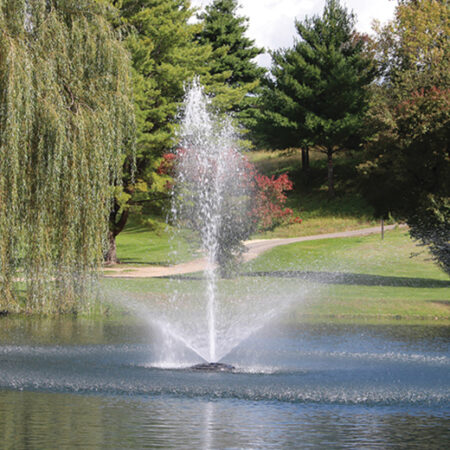Additional information
| Child override What is daylight? Daylight (or white light) is made up of a series of colours, collectively referred to as a spectrum. This is known because when a beam of white light is passed through a glass prism; the white light splits into seven visible colours with red shades at one end through to blues and violets at the other. Filters block colours When a white light source has a coloured filter placed over the beam the observer will then see the light as a colour, i.e. a green filter shows as green – blue as blue, etc. It is useful to realize that when white light hits the filter, the other colours are being blocked. The filter is allowing only certain colours of the spectrum through. REGEN-Reflect® blocks the red end of the spectrum By adding REGEN-Reflect® to water, a filter is being created to block colours from the red end of the spectrum getting through to the bottom of your pond or lake. Photosynthesis needs red light All plants, surface or submerged use the process of photosynthesis to thrive and grow and the whole process relies on red light to drive it. By adding a filter to the pond or lake water you are blocking some, or all, of the red light and the process of photosynthesis is interrupted, with the result of little or no further growth. A little about Photosynthesis All green plants need sunlight for their reproduction, the energy from sunlight acts upon a green pigment (chlorophyll) which combines with water and carbon dioxide from the local environment to produce sugars and oxygen. Chlorophyll absorbs red light (centred about 650nm). Leaves look green as blue and yellow are main colours reflected by chlorophyll. Photosynthesis is the manufacturing of sugars from carbon dioxide and water, in the presence of chlorophyll and light energy. Oxygen is then released as waste from the process. The light source used for photosynthesis is natural daylight. It is this element of photosynthesis that can be manipulated to stunt the growth of algae and submerged weeds. In a pond containing clear water, light easily passes through and any plants or nutrients present use this to grow. Plants get taller and grow towards the surface and single cell organisms (such as algae) start to float towards the surface. It is the floating, or suspended cells that can make the pond water take on the “pea green soup” look. By preventing some of the light from reaching below the surface of a pond, photosynthesis is interrupted in deep-lying pond life such as algae. However, surface life such as lily pads or reeds, which photosynthesis either on or above the surface of the water, will not be affected. As it is not practical or desirable to have ponds built indoors or permanently covered, it has become necessary to develop another way of preventing the light from reaching the base of the pond. |
| Child override 1 sachet will treat 400,000 litres Calculate the volume of water in the pond: |
| Child override Wear gloves when handling. Do not open sachets or touch the powder. Maintenance Top Ups: A general starting guide is 10-50% of the original dose each month. Powdered Dye Sachets By supplying dye powder in separate water-soluble sachets, it is easy to calculate the number required to dose a lake. In large lakes, if a boat is being used, simply drop the sachets in different areas where they will dissolve, releasing the dye. By applying the dye into different areas, the time required to fully mix with the water is reduced. If a boat is unavailable, face the water with a breeze coming from behind. Drop a few sachets along the edge and throw the others out into the water. The breeze will move the water and the dye will dissolve and disperse naturally. Liquid Dye If a boat is being used, gently pour the amount required into a wide area. The liquid dye rapidly disperses and will mix completely with all the water in the lake. If a boat is not available pour the desired amount into the water along a bank with the wind behind you. Regardless of which method is used, the water will look to have more colour in the first few days because it takes a little longer to completely mix and dilute from the top to the bottom. |
| Child override Avoid ingestion, inhalation, skin and eye contact of the powder. Do not use in or near potable (drinking) water. Wash any contaminated clothing separately. In its diluted form, Parklink’s Dye is SAFE for all aquatic creatures and for livestock to drink. |
| Child override Frequently asked questions about pond dyes Will Parklink’s dyes work in all ponds and lakes? How long will the pond dye last? I have fish in my pond, will they be safe? My pet drinks from our pond, will it be ok? Our pond is visited by frogs/newts/Insects/invertebrates/dogs/cats/rabbits/insects – will the treated water be safe for them to drink? Does dye help reduce weed growth as well as algae? The weeds in our lake are growing, is it too late to use dye? What happens if we put too much pond dye in our water? Does the pond dye stain? Is it safe to swim in water treated with Parklink pond dyes? Can we use more than the recommended dose? I have seen photographs where dye has been used and this made the water look very blue, why is that? How long does it take for the dye to mix into a pond? Will the Dye damage water pumps? Can dyes be used with other pond treatments? What do I do with unused dye? |
| Child override |
| Child override |






Reviews
There are no reviews yet.